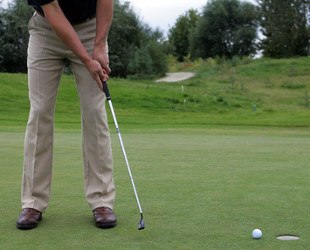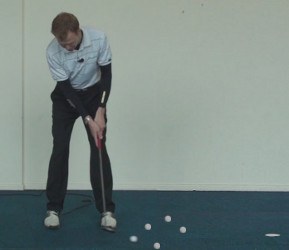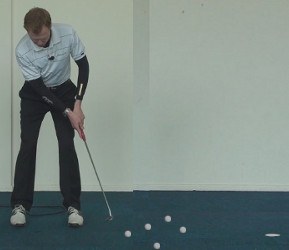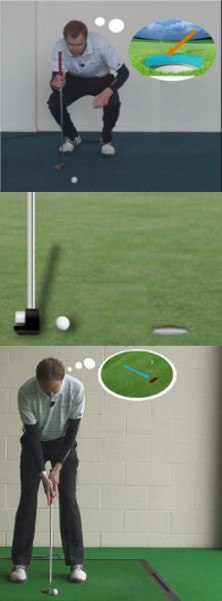
The “yips” – a tendency to miss short putts – have little to do with technique. After all, it doesn't take a perfect stroke to hole a basic 3-footer.
The vast majority of golfers suffering from the yips are wracked with fear, causing a lack of trust in their stroke. In turn, this creates tension and a habit of trying to steer or guide the ball into the cup. The golfer manipulates the putter head, usually opening or closing the face, and misses to the left, right or even short.
Think about what happens during informal rounds, when you or a playing partner declares a putt “good” from a couple of feet way. Maybe you walk up nonchalantly, without taking a stance, and slap it toward the hole. You might even backhand it with the back of the blade. More often than not, it probably goes in. Right?

In fact, your percentage of careless “makes” is likely just as high as – if not higher than – your percentage on short putts that you're trying to hole. Why? Precisely because you're not trying.
When there's no pressure or tension, you swing the putter freely. You'll still miss some of these no-effort attempts simply because you aren't lined up, or because your body is moving as you take a swipe. So think about how well you'd do if you were able to make the same tension-free stroke after aligning yourself properly.
Probably pretty well.
The key to beating the yips, then, is to rid yourself of tension and fear, which will free your stroke. Try this during your next practice session:
- Drop five balls in a circle 2-3 feet from the cup.
- Hit each ball casually, as you would if told “that's good” on the course. No need to take a stance, just step from ball to ball and knock them in.
- Count how many you make.
- Repeat the drill, only this time approach each ball as an actual putt you must make on the course. Line up, take your normal stance, and stroke it.
- Compare how many you make using the standard method vs. the casual approach.

Chances are, your results will be similar, if not better on the casual putts.
Next, set up another circle, same distance from the hole, and combine the two methods. Assume your normal stance, but take no more than one glance at the cup before hitting each putt, and don't stand over the ball more than a few seconds.
The idea is to treat these putts like what they are – easy tap-ins that you can make without even trying.
For more tips on curing your yips, click here.

Putting Cure – New Yips Fix
There are four letters in the word 'yips', and that probably isn't a coincidence. In the golf world, the word 'yips' is right up there with a bunch of other four-letter words that should not be repeated. Most golfers would rather not even think about the yips, let along have to talk about them. The yips are a destructive force on the golf course, and they can affect everyone from a total beginner to the very best players in the world. When you find yourself struggling with the yips, you will do just about anything to make them go away as fast as possible.
As you already know, the yips are an affliction that will cause you to miss short putts. While all golfers will miss the occasional short putt from time to time, someone struggling with the yips is likely to miss several within the same round. At their worst, the yips can be hard to watch, as those short misses usually won't even be close to going in. For the player who is fighting the battle against the yips, it is easy to get discouraged – some have even given up on golf altogether after trying everything they can think of to get the ball to fall into the cup.
Fortunately, it doesn't have to get to that point. With a smart game plan and plenty of practice time, you can defeat the yips just like you can defeat any other problem within your game. There is no promise that it will be easy – in fact, it is likely to be rather difficult to get over this issue. However, if you are committed to your game and committed to fixing this problem, you should be successful in the end. Once you are able to fix both your mental and physical technique, you should be able to routinely knock in your putts from three feet and in without even breaking a sweat.
The yips fix that we are going to apply in the content below is going to bring together the mental and physical tips that you need to get over this problem once and for all. Many players continue to struggle with the yips because they mistakenly believe that the problem is just one specific thing that must be fix. That is unlikely to be true. Rather, you are probably making a series of mistakes – both with your body and in your mind – which are all coming together to result in negative outcomes. The yips are a major problem within your golf game, and making one simple change is probably not going to lead you to conquering the issue. Instead, you need to be open to making a series of changes to both the way you hit your short putts, and the way you think about them as well.
All of the content below is based on a right handed golfer. If you happen to play left handed, please take a moment to reverse the directions as necessary.

Physical Fundamentals
Believe it or not, the physical side of this equation is the one that is going to be much easier to fix. If you are willing to spend some time on the practice green at your local course, you could have the physical problems within your short putting stroke sorted out in a very short amount of time. Therefore, we will start by going through the physical keys to making short putts, before moving on to the mental side of things later on. After all, if your putting stroke is faulty, no amount of proper thinking is going to force the ball to go into the hole.
The following list contains the key physical fundamentals that relate to making your short putts.
- Keep everything moving. If there is one tip that you should focus on above all of the others when it comes to short putting, it is this one. As you swing the putter head through the ball, you need to make sure that everything keeps moving all the way through the stroke. That means that the putter head, along with your hands, need to continue their motion toward the target smoothly until after the ball is gone. Players with the yips tend to struggle significantly with this point. Since they are worried about missing the putt, players with the yips will often slow down prior to impact, hoping to 'guide' the ball into the hole. Most of the time, this will lead to a miss. If you are going to make the majority of your short putts while out on the course, it is absolutely critical that you keep your stroke moving all the way through impact.
- Short backstroke. On short putts, a short backstroke is going to be the most effective way to consistently start the ball on the right line. When you make a long backstroke, you are more likely to decelerate the club prior to impact, leading to off-line putts. It is important to note, however, that a short backstroke does not need to mean a quick backstroke. You can take your time with this stroke, as most good putters use a slow and steady rhythm. As long as you don't rush, you should be able to make a short backstroke that still gives your stroke the tempo it needs to be successful.
- Head still. You probably understand this tip already, but it needs to be highlighted because it is so important to your success from short range. As you are going through the process of making your stroke, you need to keep your head perfectly still, with your eyes trained on the ball until after it has been struck. Many players – especially those with the yips – are tempted to look up early to see where the ball is going. Unfortunately, the action of looking up early can lead to missed putts when you pull the putter out of position prior to impact. It isn't going to do you any good to look at the home prematurely, so dedicate yourself to keeping your head still and only look up once the ball is safely off of the putter face.
- Knees still. This is a tip that is not as well-known as keeping your head still, but it is almost as important. Many players with the yips will allow their knees to move around during the stroke, which can easily cause the putter to get off track. Specifically, it is common for the left knee to move back away from the ball during the forward stroke. As you are swinging the putter back and through, focus on maintaining the position of your knees and you will suddenly find it much easier to start the ball on the correct line.
- Relaxed grip pressure. The last physical tip on our list is a reminder to keep your grip pressure as light as possible while swinging the putter. Since you are only making a small little stroke with very little speed through impact, you don't need much grip pressure at all to maintain control of the club. Therefore, keep your hands light on the grip as you hit your short putts. That light grip will make it easier to swing the putter freely, which should result in hitting your target line more frequently than you would with a tight grip.
If you were able to hit all five points on the list above with your short putting technique, you would likely make the vast majority of your putts – even if your mental game was faulty in some way. Great physical technique can make up for a lot of other mistakes in golf, so make sure to spend some practice time working on each of these points.

How to Practice Your Short Putts
Once you have done some work on the physical points of your stroke, it is a good idea to move into some practice drills to engrain those important physical fundamentals listed above. Practice doesn't make perfect in golf, but it certainly does make you better. For most people, putting practice involves dropping a ball on the green and rolling a few putts back and forth before heading to the first tee. Of course, you can do a lot better than that, and you will get much better results if you have a plan for your practice. Following are three specific practice putting routines that you can work through if you would like to improve your performance from short range.
- Five ball ladder. This is one of the most popular short putting drills, and for good reason. While this drill will take you outside of typical 'yip range', it is still applicable to the process of eliminating the yips from your stroke. To complete this drill, find a relatively flat spot on the practice green and place five balls down on the ground. You should position the five balls in a row, each one a foot farther from the hole than the one previous. So, when set up, you will have a ball positioned at one foot, two feet, three feet, four feet, and five feet from the hole. From there, it is your task to simply make all five in a row, starting with the shortest putt and moving out. If your stroke is working nicely, this will be an easy drill. If not, you will quickly find out that you still have work to do. This drill is great for finding problems within your stroke, but it is also excellent for building confidence. Once you are able to complete this drill successfully over and over, you will be full of confidence over short putts during your next round.
- Twenty straight makes. The name of this drill says it all – you are going to attempt to make 20 consecutive putts, each over flat ground from three feet. There are two things that will be accomplished while working on this drill. First, you will be testing the physical quality of your stroke. If you still have problems within your technique, you will likely miss within the first few putts. Second, you will test the ability of your stroke to hold up under pressure. Even if there is nothing on the line, you will still start to feel some pressure when you get down to the last few putts, having already make 15 or so in a row. It is great to put yourself under this kind of pressure during practice, as it emulates the feelings that you will have on the course.
- Dead center. For this last drill, you are going to need a tee which you will push into the back of the cup, just an inch or so below the surface of the green (be careful as to avoid damaging the cup itself). With the tee in place, line up a few putts from three feet and do your best to hit the tee in the back of the cup. This drill will help you narrow your focus – it isn't good enough just to make the putt in this drill, as your target is much smaller than the entire hole. After a few repetitions of trying to hit the tee, take the tee out of the cup and go back to just holing putts normally. Most likely, the cup will start to look much bigger after you have completed this quick drill.
There is no substitute for repetition in golf, so hitting as many short putts as possible is going to be great for your confidence and your overall performance. Use the drills listed above to guide your upcoming practice sessions as you work to eliminate the yips from your game once and for all.

Mind Games on the Green
The mental side of golf really kicks into gear when you get on the putting green. Sure, you can get nervous and feel pressure when making a full swing, but those feelings are nothing like what you can find on the green when trying to hole out. If you are playing in a big match or tournament at your club, or if you are trying to close out a round that would be a new personal best score, you are sure to feel the nerves while putting from short range. For golfers who have a tendency to yip their short putts, that tendency will come to the surface when the pressure is on.
There are a variety of ways you can choose to deal with the pressure that you are feeling while trying to make a short putt. The first thing that you need to understand is that there is nothing wrong with feeling nervous, and you shouldn't run from that feeling. Golfers who try to pretend that they aren't nervous are only fooling themselves, as the nerves are still in there whether they like to admit it or not. The goal is not to get over the nerves and have them removed from the equation – instead, the goal is to learn how to perform your best while feeling nervous. You can be sure that the top professional golfers in the world still get nervous, yet they have learned how to play well even while under pressure.
Following is a list of tips that you can use to summon up your best putting stroke from short range even while you are feeling nervous.
- Focus on the basics. During times of stress on the green, take your mind back to the basics of the physical side of the putting stroke that we discussed above. By taking your mind off of the consequences of a miss, you can relieve some of the pressure that you are feeling. Go through your pre-shot routine and make sure your fundamentals are in place prior to stroking the putt. If you can successfully immerse yourself in the process of the putt, the pressure that you are feeling might not have a chance to interfere.
- Think about successful experiences. At some point in the past, you have done a good job of holing out your short putts under pressure. Think back to those experiences and draw on them for confidence. Remember a time that you were nervous over a tough three footer – only to knock it right in the back of the cup. Success leads to confidence in golf, and confidence is one sure way to destroy the yips. Call on your previous successes to stir up positive thoughts in your mind, and your putting stroke should quickly get back on track.
- Pick a specific target. This point has a lot in common with the putting drill from above where we placed a tee in the back of the cup. Rather than standing over your three footer while simply aiming for the hole, pick out a very specific target that you can use to focus your attention. There is almost always something on the putting green that you can aim for, whether it is a discolored spot, or a blade of grass that stands out from the rest. Narrow your focus in on this very specific target and then do your best to roll the ball perfectly over that spot.
- Don't waste time. There is a fine line between moving quickly over your short putts and rushing through the stroke. You don't want to feel rushed, but you also don't want to stand over the ball so long that you start to freeze up. To get into a good rhythm and prevent the nerves from wrecking your stroke, try taking just one look at the hole before starting your stroke. Stand over the ball, look up once at the hole, and start the stroke as soon as your eyes return to the ball. This quick tempo is used by many of the world's top players to great effect, and it should be able to help you too.
For most players, the yips are a combination of mental and physical errors, and they will only be gone when you have addressed both sides of the equation. Hopefully the tips above will help you sort out the way you think on the putting green when faced with a short putt. That improved thinking, along with your improved physical mechanics, may be enough to completely eliminate any sign of the dreaded yips.

No Such Thing as a Gimme
One of the worst things you can do for your golf game is to take 'gimme' putts when playing casual rounds with your friends. On the surface, it seems harmless enough. You roll your ball up to within a couple feet of the hole, one of your friends says 'that's good', and you knock the ball away without bothering to putt out. Unfortunately, this casual approach to putting is exactly what can permit the yips to develop. If you make it a habit to skip the step of knocking in your short putts, you will soon find that they are much more difficult than you remember.
In a perfect world, there would be no gimmes in golf. Taking a short putt without actually knocking it in the hole serves no real purpose, but it can cause harm to your game if you later enter a competition where you will be required to putt out. If you would like to prevent the yips from setting in within your game, or if you would like to keep them away after you fix them, make it a habit to putt out each and every time. You will gain confidence from seeing the ball fall in hole after hole, and you won't have to worry about forgetting how to make your short ones later on down the line.
There is nothing good about the yips. They can quickly add strokes to your scorecard, and they make golf feel more like a chore than an enjoyable activity. If you would like to get rid of the yips once and for all, be sure to address both the physical and mental side of the problem. Using the advice contained above, you should be able to conquer this issue quickly and get your game back on track in the near future.






